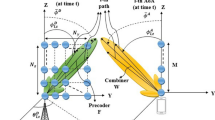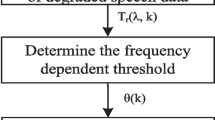Abstract
Usually Acoustic Echo Cancellers (AECs) are realized by adaptive Finite duration Impulse Response (FIR) filter having large number of coefficients and Least Mean Square (LMS) as an adaptive algorithm resulting in slow convergence speed and poor tracking performance of these adaptive filters. In this paper, we have proposed a Multiple Sub-filter (MSF) parallel structure based on multipath acoustic echo model using the basis that each sub-filter will compensate the echo contributed by each path of multipath acoustic channel. To realize the MSF, modified Generalized Autocorrelation-based Estimator (MAE) has been used to estimate time delay associated with each path while the order of each sub-filter has been estimated using Power Spectral Density (PSD) method. Accuracy Percentage (AP) performance measure has been used to characterize the performance of the estimator. Simulation results show that the performance of the MAE improves with the increase in SNR and/or decrease in number of multipath. Using these estimates MSF based AEC is constructed. The convergence performance of MSF-based AEC has been studied, via computer simulation, and compared with the conventional Single Long length adaptive Filter (SLF)-based canceller for different SNRs and number of multipath. The results of MSF have been found to be very encouraging in almost all of the various situations considered. Subsequently, the tracking behavior has also been studied with variation in the channel parameters of the multipath model. The proposed MSF can track variations in the channel parameters of the multipath model faster as compared to the conventional echo canceller.



























Similar content being viewed by others
References
J.B. Allen, D.A. Berkley, Image method for efficiently simulating small room acoustics. J. Acoust. Soc. Am. 65(4), 943–950 (1979)
A. Barik, T.P. Bhardwaj, R. Nath, A family of multiple sub-filters based acoustic echo cancellers, in Proc. 1st ACM Int. Conf. Intelligent Interactive Technologies and Multimedia (IITM’2010), Allahabad, India (2010)
J. Benesty, D.R. Morgan, M.M. Sondhi, A hybrid mono/stereo acoustic echo canceller. IEEE Trans. Acoust. Speech Signal Process. 6(5), 468–475 (1998)
J. Benesty, T. Gänsler, D.R. Morgan, M.M. Sondhi, S.L. Gay, Advances in Network and Acoustic Echo Cancellation (Springer, Berlin, 2001)
J. Benesty, Y. Huang, Adaptive Signal Processing-Application to Real-World Problems (Springer, Berlin, 2003)
J. Benesty, T. Gänsler, A multidelay double-talk detector combined with the MDF adaptive filter. EURASIP J. Appl. Signal Process. 2003(11), 1050–1063 (2003)
T.P. Bhardwaj, R. Nath, Maximum likelihood estimation of the time delays in multipath acoustic channel. Signal Process. 90(5), 1750–1754 (2010)
C. Breining, P. Dreiseitel, E. Hänsler, A. Mader, B. Nitsch, H. Puder, T. Schertler, G. Schmidt, J. Tilp, J.S. Lee, Acoustic echo control—an application of very-high-order adaptive filters. IEEE Signal Process. Mag. 16(4), 42–69 (1999)
G.C. Carter (ed.), Special issue on time delay estimation. IEEE Trans. Acoust. Speech Signal Process. ASSP-29, 3 (1981)
Digital Network Echo Cancellers, ITU Recommendation G.168 (2002)
B. Friedlander, On the Cramer–Rao bound for time delay and Doppler estimation. IEEE Trans. Inf. Theory IT-30(3), 575–580 (1984)
E. Hänsler, The hands-free telephone problem—an annotated bibliography. Signal Process. 27(3), 259–271 (1992)
J.P. Ianniello, Large and small error performance limits for multipath time delay estimation. IEEE Trans. Acoust. Speech Signal Process. ASSP-34(2), 245–251 (1986)
J.P. Ianniello, High resolution multipath time delay estimation for broad-band random signals. IEEE Trans. Acoust. Speech Signal Process. 36(3), 320–327 (1988)
A. Kar, R. Nath, A. Barik, A VLMS based pseudo-fractional optimum order estimation algorithm, in Proc. of the 2011 International Conference on Communication, Computing and Security (ICCCS2011), Rourkela, India (2011)
W. Kellermann, Current topics in adaptive filtering for hands-free acoustic communication and beyond. Signal Process. 80(9), 1695–1696 (2000)
A.P. Liavas, P.A. regalia, On the behavior of information theoretic criteria for model order selection. IEEE Trans. Signal Process. 49(8), 1689–1695 (2001)
K. Mayyas, New transform-domain adaptive algorithms for acoustic echo cancellation. Digit. Signal Process. 13(3), 415–432 (2003)
K. Mayyas, T. Aboulnasr, Reduced-complexity transform-domain adaptive algorithm with selective coefficient update. IEEE Trans. Circuits Syst. II, Express Briefs 51(3), 136–142 (2004)
P.P. Moghaddam, H. Amindawar, Estimation of multipath parameters for nonresolvable time delays, in IEEE NORDIC Signal Processing Symposium (NORSIG 2000), Kolmoarden, Sweden (2000)
P.P. Moghaddam, H. Amindavar, R.L. Kirlin, A new time-delay estimation in multipath. IEEE Trans. Signal Process. 51(5), 1129–1142 (2003)
R. Nath, Modified generalized autocorrelation based estimator for time delays in multipath environment—a tradeoff in estimator performance and number of multipath. Comput. Electr. Eng. 37(3), 241–252 (2011)
M. Niedzwiecki, Identification of Time-Varying Processes (Wiley, New York, 2000)
R.N. Sharma, A.K. Chaturvedi, G. Sharma, Acoustic echo cancellation using multiple sub-filter, in IEEE TENCON 2003, vol. 1 (2003), pp. 393–396
R.N. Sharma, A.K. Chaturvedi, G. Sharma, Multipath delay estimation for acoustic echo channel, in IEEE TENCON 2004, vol. 1 (2004), pp. 21–24
R. Sharma, A.K. Chaturvedi, G. Sharma, Tracking behaviour of acoustic echo canceller using multiple sub-filters, in 14th European Signal Processing Conference, EUSIPCO-2006, Florence, Italy (2006)
M.M. Sondhi, D.A. Berkley, Silencing echoes on the telephone networks. Proc. IEEE 68(8), 948–963 (1980)
Author information
Authors and Affiliations
Corresponding author
Rights and permissions
About this article
Cite this article
Nath, R. Adaptive Echo Cancellation Based on a Multipath Model of Acoustic Channel. Circuits Syst Signal Process 32, 1673–1698 (2013). https://doi.org/10.1007/s00034-012-9529-4
Received:
Revised:
Published:
Issue Date:
DOI: https://doi.org/10.1007/s00034-012-9529-4




